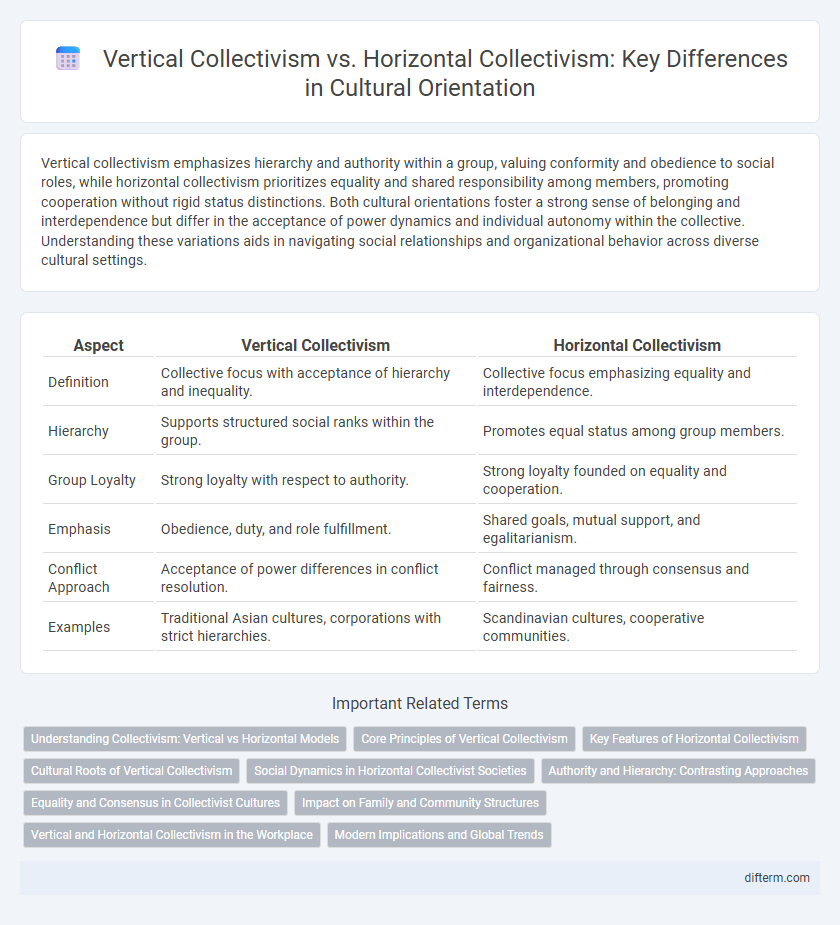Vertical collectivism emphasizes hierarchy and authority within a group, valuing conformity and obedience to social roles, while horizontal collectivism prioritizes equality and shared responsibility among members, promoting cooperation without rigid status distinctions. Both cultural orientations foster a strong sense of belonging and interdependence but differ in the acceptance of power dynamics and individual autonomy within the collective. Understanding these variations aids in navigating social relationships and organizational behavior across diverse cultural settings.
Table of Comparison
| Aspect | Vertical Collectivism | Horizontal Collectivism |
|---|---|---|
| Definition | Collective focus with acceptance of hierarchy and inequality. | Collective focus emphasizing equality and interdependence. |
| Hierarchy | Supports structured social ranks within the group. | Promotes equal status among group members. |
| Group Loyalty | Strong loyalty with respect to authority. | Strong loyalty founded on equality and cooperation. |
| Emphasis | Obedience, duty, and role fulfillment. | Shared goals, mutual support, and egalitarianism. |
| Conflict Approach | Acceptance of power differences in conflict resolution. | Conflict managed through consensus and fairness. |
| Examples | Traditional Asian cultures, corporations with strict hierarchies. | Scandinavian cultures, cooperative communities. |
Understanding Collectivism: Vertical vs Horizontal Models
Vertical collectivism emphasizes strong hierarchical relationships and acceptance of authority within group structures, prioritizing duty and deference to leaders. Horizontal collectivism, in contrast, promotes equality and cooperation among group members, valuing shared responsibility and collective well-being without rigid social rankings. Understanding these models reveals how cultural contexts influence social behavior, decision-making, and group dynamics across societies.
Core Principles of Vertical Collectivism
Vertical collectivism emphasizes hierarchical relationships and acceptance of authority within the group, prioritizing duty, loyalty, and respect for social norms. Individuals often subordinate personal goals to group objectives, reinforcing structured social roles and responsibilities. This cultural orientation supports a clear distinction between leaders and followers, fostering cohesion through obedience and interdependence.
Key Features of Horizontal Collectivism
Horizontal collectivism emphasizes equality and interdependence among group members, promoting cooperation without hierarchical distinctions. It values shared responsibility and collective decision-making while maintaining individual autonomy within the group. This cultural orientation fosters strong social support networks and prioritizes harmony and consensus in group interactions.
Cultural Roots of Vertical Collectivism
Vertical collectivism emerges from hierarchical social structures where respect for authority and group conformity are emphasized, often rooted in Confucian values and traditional family systems. This cultural orientation prioritizes duty, obligation, and social order within tightly knit communities that accept inequality as a natural aspect of relationships. Societies in East Asia and parts of South Asia commonly exhibit vertical collectivist traits, reflecting long-standing historical norms and institutional practices that reinforce vertical social stratification.
Social Dynamics in Horizontal Collectivist Societies
Social dynamics in horizontal collectivist societies emphasize egalitarian relationships, fostering collaboration and mutual support among group members without hierarchical distinctions. These societies prioritize group harmony and shared responsibilities, promoting inclusive decision-making processes that strengthen social cohesion. Interpersonal interactions are characterized by cooperation and equal status, enhancing trust and collective well-being within the community.
Authority and Hierarchy: Contrasting Approaches
Vertical collectivism emphasizes authority and hierarchy by valuing obedience to established ranks and clear power differentials within groups, often seen in traditional or rigidly structured societies. Horizontal collectivism promotes equality and de-emphasizes hierarchical distinctions, encouraging collaboration and egalitarian relationships among group members. These contrasting approaches shape social dynamics, affecting decision-making, leadership styles, and interpersonal interactions within cultural contexts.
Equality and Consensus in Collectivist Cultures
Vertical collectivism emphasizes hierarchical relationships where individuals accept inequality and authority within the group, prioritizing duty and obedience over equality. In contrast, horizontal collectivism promotes equal status among group members, fostering consensus and cooperation without strict social rankings. Both forms value group harmony, but horizontal collectivism uniquely integrates equality as a core principle alongside collective goals.
Impact on Family and Community Structures
Vertical collectivism emphasizes hierarchical family roles and clear authority lines, reinforcing obedience and respect within family and community structures. In contrast, horizontal collectivism promotes equality and shared responsibility, fostering cooperative decision-making and mutual support among family members and community groups. These orientations critically shape social cohesion, communication patterns, and conflict resolution strategies in culturally collectivist societies.
Vertical and Horizontal Collectivism in the Workplace
Vertical collectivism in the workplace emphasizes hierarchical structures where loyalty to the group coexists with acceptance of authority and unequal power distribution. Horizontal collectivism promotes teamwork and equality, encouraging collaboration among employees on the same level without rigid status differences. Understanding these cultural dimensions helps organizations tailor leadership styles and communication strategies to enhance group cohesion and productivity.
Modern Implications and Global Trends
Vertical collectivism emphasizes hierarchical group structures and acceptance of inequality, influencing organizational dynamics in cultures with strong authority respect, while horizontal collectivism promotes equality and collaboration among members, fostering flatter, more democratic social systems. Modern implications include diverse leadership styles and conflict resolution methods shaped by these cultural orientations, impacting multinational companies' management and teamwork strategies. Global trends reveal a gradual shift toward horizontal collectivism in urbanized and digital societies, promoting inclusivity and shared responsibility across borders.
vertical collectivism vs horizontal collectivism Infographic

 difterm.com
difterm.com